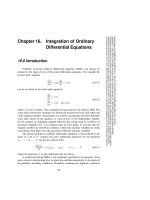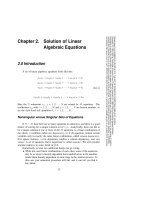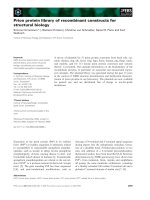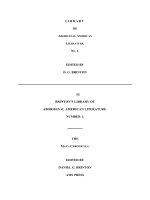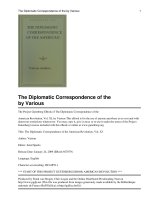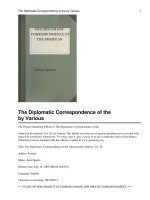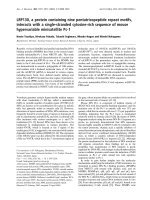LIBRARY OF ABORIGINAL AMERICAN LITERATURE. No. 1 doc
Bạn đang xem bản rút gọn của tài liệu. Xem và tải ngay bản đầy đủ của tài liệu tại đây (783.31 KB, 201 trang )
L I B R A R Y
OF
ABORIGINAL AMERICAN
LITERATURE.
No. 1.
EDITED BY
D. G. BRINTON
[i]
BRINTON’S LIBRARY OF
ABORIGINAL AMERICAN LITERATURE.
NUMBER 1.
THE
MAYA CHRONICLES.
EDITED BY
DANIEL G. BRINTON
AMS PRESS
NEW YORK
Reprinted from the edition of 1882, Philadelphia
First AMS EDITION published 1969
Manufactured in the United States of America
Library of Congress Catalogue Card Number: 70-83457
AMS PRESS, INC.
New York, N.Y. 10003
[iii]
TO THE MEMORY
OF
CARL HERMANN BERENDT, M.D.,
WHOSE LONG AND EARNEST DEVOTION TO THE ETHNOLOGY
AND LINGUISTICS OF AMERICA HAS MADE THIS WORK
POSSIBLE, AND WHOSE UNTIMELY DEATH HAS
LOST TO AMERICAN SCHOLARS RESULTS
OF FAR GREATER IMPORTANCE,
THIS VOLUME IS DEDICATED.
[vi]
[v]
PREFACE.
The belief that the only solid foundation for the accurate study of American
ethnology and linguistics must be in the productions of the native mind in their
original form has led me to the venturesome undertaking of which this is the first
issue. The object of the proposed series of publications is to preserve permanently a
number of rude specimens of literature composed by the members of various
American tribes, and exhibiting their habits of thought, modes of expressions,
intellectual range and æsthetic faculties.
Whether the literary and historical value of these monuments is little or great,
they merit the careful attention of all who would weigh and measure the aboriginal
mind, and estimate its capacities correctly.
The neglect of this field of study is largely owing to a deficiency of material for
its pursuit. Genuine specimens of native literature are rare, and almost or quite
inaccessible. They remain in manuscript in the hands of a few collectors, or, if printed,
they are in forms not convenient to obtain, [vi]as in the ponderous transactions of
learned societies, or in privately printed works. My purpose is to gather together from
these sources a dozen volumes of moderate size and reasonable price, and thus to put
the material within the reach of American and European scholars.
Now that the first volume is ready, I see in it much that can be improved upon in
subsequent issues. I must ask for it an indulgent criticism, for the novelty of the
undertaking and its inherent difficulties have combined to make it less finished and
perfected than it should have been.
If the series meets with a moderate encouragement, it will be continued at the rate
of two or three volumes of varying size a year, and will, I think, prove ultimately of
considerable service to the students of man in his simpler conditions of life and
thought, especially of American man.
[vii]
CONTENTS.
INTRODUCTION.
§ 1. The Name Maya, p. 9. § 2. The Maya Linguistic Family, p. 17. § 3. Origin of the
Maya Tribes, p. 20. § 4. Political Condition at the Time of the Conquest, p. 25. § 5.
Grammatical Observations, p. 27. § 6. The Numeral System, p. 37. § 7. The
Calendar, p. 50. § 8. Ancient Hieroglyphic Books, p. 61. § 9. Modern Maya
Manuscripts, p. 67. § 10. Grammars and Dictionaries, p. 72.
THE CHRONICLES.
INTRODUCTORYp. 81
I. The Series of the Katuns, p. 89. Text, p. 95. Translation, p. 100. Notes, p. 106.
II. The Series of the Katuns, p. 136. Text, p. 138. Translation, p. 144. Notes, p. 150.
III. The Record of the Count of the Katuns, p. 152. Text, p. 153. Translation, p. 158.
Notes, p. 163.
IV.
The Maya Katuns, p. 165. Text, p. 166. Translation, p. 169. Notes, p. 173.
V. The Chief Katuns, p. 177. Text, p. 178. Translation, p. 180. Notes, p. 182.
THE CHRONICLE OF CHAC XULUB CHEN.
Introductory, p. 189. Text, p. 193. Translation, p. 216. Notes, p. 242.
VOCABULARYp. 261
[viii]
[9]
I.
INTRODUCTION.
CONTENTS.
1. THE NAME “MAYA.” 2. THE MAYA LINGUISTIC FAMILY. 3. ORIGIN OF THE MAYA
TRIBES. 4. POLITICAL CONDITION AT THE TIME OF THE CONQUEST. 5.
GRAMMATICAL OBSERVATIONS. 6. THE NUMERAL SYSTEM. 7. THE CALENDAR. 8.
ANCIENT HIEROGLYPHIC BOOKS. 9. MODERN MAYA MANUSCRIPTS. 10.
GRAMMARS AND DICTIONARIES OF THE LANGUAGE.
§ 1. The Name “Maya.”
In his second voyage, Columbus heard vague rumors of a mainland westward
from Jamaica and Cuba, at a distance of ten days’ journey in a canoe.9-1 Its
inhabitants were said to be clothed, and the specimens of wax which were found
among the Cubans must have been brought [10]from there, as they themselves did not
know how to prepare it.
During his fourth voyage (1503-4), when he was exploring the Gulf southwest
from Cuba, he picked up a canoe laden with cotton clothing variously dyed. The
natives in it gave him to understand that they were merchants, and came from a land
called MAIA.10-1
This is the first mention in history of the territory now called Yucatan, and of the
race of the Mayas; for although a province of similar name was found in the western
extremity of the island of Cuba, the similarity was accidental, as the evidence is
conclusive that no colony of the Mayas was found on the Antilles.10-2 These islands
were [11]peopled by a wholly different stock, the remnants of whose language prove
them to have been the northern outposts of the Arawacks of Guiana, and allied to the
great Tupi-Guaranay stem of South America.
MAYA was the patrial name of the natives of Yucatan. It was the proper name of
the northern portion of the peninsula. No single province bore it at the date of the
Conquest, and probably it had been handed down as a generic term from the period,
about a century before, when this whole district was united under one government.
The natives of all this region called themselves Maya uinic, Maya men, or ah
Mayaa, those of Maya; their language was Maya than, the Maya speech; a native
woman was Maya cħuplal; and their ancient capital wasMaya pan,
the MAYA [12]banner, for there of old was set up the standard of the nation, the
elaborately worked banner of brilliant feathers, which, in peace and in war, marked
the rallying point of the Confederacy.
We do not know where they drew the line from others speaking the same tongue.
That it excluded the powerful tribe of the Itzas, as a recent historian thinks,12-1 seems
to be refuted by the documents I bring forward in the present volume; that, on the
other hand, it did not include the inhabitants of the southwestern coast appears to be
indicated by the author of one of the oldest and most complete dictionaries of the
language. Writing about 1580, when the traditions of descent were fresh, he draws a
distinction between the lengua de Maya and thelengua de Campeche.12-2 The latter
was a dialect varying very slightly from pure Maya, and I take it, this manner of
indicat[13]ing the distinction points to a former political separation.
The name Maya is also found in the form Mayab, and this is asserted by various
Yucatecan scholars of the present generation, as Pio Perez, Crescencio Carrillo, and
Eligio Ancona, to be the correct ancient form, while the other is but a
Spanish corruption.13-1
But this will not bear examination. All the authorities, native as well as foreign,
of the sixteenth century, writeMaya. It is impossible to suppose that such laborious
and earnest students as the author of the Dictionary of Motul, as the grammarian and
lexicographer Gabriel de San Buenaventura, and as the educated natives whose
writings I print in this volume, could all have fallen into such a capital blunder.13-2
The explanation I have to offer is just the re[14]verse. The use of the terminal b in
“Mayab” is probably a dialectic error, other examples of which can be quoted. Thus
the writer of the Dictionary of Motul informs us that the form maab is sometimes used
for the ordinary negative ma, no; but, he adds, it is a word of the lower classes,es
palabra de gente comun. So I have little doubt but that Mayab is a vulgar form of the
word, which may have gradually gained ground.
As at present used, the accent usually falls on the first syllable, Ma´ya, and the
best old authorities affirm this as a rule; but it is a rule subject to exceptions, as at the
end of a sentence and in certain dialects Dr. Berendt states that it is not infrequently
heard as Ma´ya´ or even Maya´.14-1
The meaning and derivation of the word have given rise to the usual number of
nonsensical and far-fetched etymologies. The Greek, the Sanscrit, the ancient Coptic
and the Hebrew have all been called in to interpret it. I shall refer to but a few of these
profitless suggestions.
The Abbé Brasseur (de Bourbourg) quotes as the opinion of Don Ramon de
Ordoñez, the author of a strange work on American archæ[15]ology, called History of
the Heaven and the Earth, that Maya is but an abbreviation of the phrase ma ay ha,
which, the Abbé adds, means word for word, non adest aqua, and was applied to the
peninsula on account of the scarcity of water there.15-1
Unfortunately that phrase has no such, nor any, meaning in Maya; were it ma yan
haa, it would have the sense he gives it; and further, as the Abbé himself remarked in
a later work, it is not applicable to Yucatan, where, though rivers are scarce, wells and
water abound. He therefore preferred to derive it from ma and ha, which he thought he
could translate either “Mother of the Water,” or “Arm of the Land!”15-2
The latest suggestion I have noticed is that of Eligio Ancona, who, claiming
that Mayab is the correct form, and that this means “not numerous,” thinks that it was
applied to the first native settlers of the land, on account of the paucity of
their numbers!15-3
All this seems like learned trifling. The name may belong to that ancient dialect
from which are derived many of the names of the days and [16]months in the native
calendar, and which, as an esoteric language, was in use among the Maya priests, as
was also one among the Aztecs of Mexico. Instances of this, in fact, are very common
among the American aborigines, and no doubt many words were thus preserved which
could not be analyzed to their radicals through the popular tongue.
Or, if it is essential to find a meaning, why not accept the obvious signification of
the name? Ma is the negative “no,” “not;” ya means rough, fatiguing, difficult,
painful, dangerous. The compound maya is given in the Dictionary of Motul with the
translations “not arduous nor severe; something easy and not difficult to do;” cosa no
grave ni recia; cosa facil y no dificultosa de hacer. It was used adjectively as in the
phrase, maya u chapahal, his sickness is not dangerous. So they might have spoken of
the level and fertile land of Yucatan, abounding in fruit and game, that land to which
we are told they delighted to give, as a favorite appellation, the term u luumil ceh, u
luumil cutz, the land of the deer, the land of the wild turkey; of this land, I say, they
might well have spoken as of one not fatiguing, not rough nor exhausting.
[17]§ 2. The Maya Linguistic Family.
Whatever the primitive meaning and first application of the name Maya, it is now
used to signify specifically the aborigines of Yucatan. In a more extended sense, in the
expression “the Maya family,” it is understood to embrace all tribes, wherever found,
who speak related dialects presumably derived from the same ancient stock as the
Maya proper.
Other names for this extended family have been suggested, as Maya-Kiche,
Mam-Huastec, and the like, compounded of the names of two or more of the tribes of
the group. But this does not appear to have much advantage over the simple
expression I have given, though “Maya-Kiche” may be conveniently employed to
prevent confusion.
These affiliated tribes are, according to the investigations of Dr. Carl Hermann
Berendt, the following:—
1. The Maya proper, including the Lacandons.
2. The Chontals of Tabasco, on and near the coast west of the mouth of the
Usumacinta.
3. The Tzendals, south of the Chontals.
4. The Zotzils, south of the Tzendals.
5. The Chaneabals, south of the Zotzils.
[18]6.
The Chols, on the upper Usumacinta.
7. The Chortis, near Copan.
8. The Kekchis, and
9. The Pocomchis, in Vera Paz.
10. The Pocomams.
11. The Mams.
12. The Kiches.
13. The Ixils. In or bordering on Guatemala.
14. The Cakchiquels.
15.
The Tzutuhils.
16. The Huastecs, on the Panuco river and its tributaries, in Mexico.
The languages of these do not differ more, in their extremes, than the French,
Spanish, Italian and other tongues of the so-called Latin races; while a number
resemble each other as closely as the Greek dialects of classic times.
What lends particular importance to the study of this group of languages is that it
is that which was spoken by the race in several respects the most civilized of any
found on the American continent. Copan, Uxmal and Palenque are names which at
once evoke the most earnest interest in the mind of every one who has ever been
attracted to the subject of the archæology of the New World. This race, moreover,
possessed [19]an abundant literature, preserved in written books, in characters which
were in some degree phonetic. Enough of these remain to whet, though not to satisfy,
the curiosity of the student.
The total number of Indians of pure blood speaking the Maya proper may be
estimated as nearly or quite 200,000, most of them in the political limits of the
department of Yucatan; to these should be added nearly 100,000 of mixed blood, or of
European descent, who use the tongue in daily life.19-1 For it forms one of the rare
examples of American languages possessing vitality enough not only to maintain its
own ground, but actually to force itself on European settlers and supplant their native
speech. It is no uncommon occurrence in Yucatan, says Dr. Berendt, to find whole
families of pure white blood who do not know one word of Spanish, using the Maya
exclusively. It has even intruded on literature, and one finds it interlarded in books
published in Merida, very [20]much as lady novelists drop into French in their
imaginative effusions.20-1
The number speaking the different dialects of the stock are roughly estimated at
half a million, which is probably below the mark.
§ 3. Origin of the Maya Tribes.
The Mayas did not claim to be autochthones. Their legends referred to their
arrival by the sea from the East, in remote times, under the leadership of Itzamna, their
hero-god, and also to a less numerous, immigration from the west, from Mexico,
which was connected with the history of another hero-god, Kukul Càn.
The first of these appears to be wholly mythical, and but a repetition of the story
found among so many American tribes, that their ancestors came from the distant
Orient. I have elsewhere explained this to be but a solar or light myth.20-2
The second tradition deserves more attention from the historian, as it is supported
by some of their chronicles and by the testimony of several [21]of the most intelligent
natives of the period of the conquest, which I present on a later page of this volume.
It cannot be denied that the Mayas, the Kiches and the Cakchiquels, in their most
venerable traditions, claimed to have migrated from the north or west, from some part
of the present country of Mexico.
These traditions receive additional importance from the presence on the shores of
the Mexican Gulf, on the waters of the river Panuco, north of Vera Cruz, of a
prominent branch of the Maya family, the Huastecs. The idea suggests itself that these
were the rearguard of a great migration of the Maya family from the north toward the
south.
Support is given to this by their dialect, which is most closely akin to that of the
Tzendals of Tabasco, the nearest Maya race to the south of them, and also by very
ancient traditions of the Aztecs.
It is noteworthy that these two partially civilized races, the Mayas and the Aztecs,
though differing radically in language, had legends which claimed a community of
origin in some indefinitely remote past. We find these on the Maya side
narrated [22]in the sacred book of the Kiches, the Popol Vuh, in the
Cakchiquel Records of Tecpan Atitlan, and in various pure Maya sources which I
bring forward in this volume. The Aztec traditions refer to the Huastecs, and a brief
analysis of them will not be out of place.
At a very remote period the Mexicans, under their leader Mecitl, from whom they
took their name, arrived in boats at the mouth of the river Panuco, at the place called
Panotlan, which name means “where one arrives by sea.” With them were the Olmecs
under their leader Olmecatl, the Huastecs, under their leader Huastecatl, the Mixtecs
and others. They journeyed together and in friendship southward, down the coast,
quite to the volcanoes of Guatemala, thence to Tamoanchan, which is described as
the terrestial paradise, and afterwards, some of them at least, northward and eastward,
toward the shores of the Gulf.
On this journey the intoxicating beverage made from the maguey, called octli by
the Aztecs, cii by the Mayas, and pulque by the Spaniards, was invented by a woman
whose name was Mayauel, in which we can scarcely err in recognizing
the [23]national appellation Maya.23-1 Furthermore, the invention is closely related to
the history of the Huastecs. Their leader, alone of all the chieftains, drank to excess,
and in his drunkenness threw aside his garments and displayed his nakedness. When
he grew sober, fear and shame impelled him to collect all those who spoke his
language, and leaving the other tribes, he returned to the neighborhood of Panuco and
settled there permanently.23-2
The annals of the Aztecs contain frequent allusions to the Huastecs. The most
important contest between the two nations took place in the reign of Montezuma the
First (1440-1464). The attack was made by the Aztecs, for the alleged reason that the
Huastecs had robbed and killed Aztec merchants on their way to the great fairs in
Guatemala. The Huastecs are described as numerous, dwelling in walled towns,
possessing quantities of maize, beans, feathers and precious stones, and painting their
faces. They were sig[24]nally defeated by the troops of Montezuma, but not reduced
to vassalage.24-1
At the time of the Conquest the province of the Huastecs was densely peopled;
“none more so under the sun,” remarks the Augustinian friar Nicolas de Witte, who
visited it in 1543; but even then he found it almost deserted and covered with ruins,
for, a few years previous, the Spaniards had acted towards its natives with customary
treachery and cruelty. They had invited all the chiefs to a conference, had enticed
them into a large wooden building, and then set fire to it and burned them alive. When
this merciless act became known the Huastecs deserted their villages and scattered
among the forests and mountains.24-2
These traditions go to show that the belief among the Aztecs was that the tribes of
the Maya family came originally from the north or northeast, and were at some remote
period closely connected with their own ancestors.
[25]§ 4. Political Condition at the Time of the Conquest.
When the Spaniards first explored the coasts of Yucatan they found the peninsula
divided into a number of independent petty states. According to an authority followed
by Herrera, these were eighteen in number. There is no complete list of their names,
nor can we fix with certainty their boundaries. The following list gives their
approximate position. On the west coast, beginning at the south—
1.
Acalan, on the Bahia de Terminos.
2.
Tixchel (or Telchac?)
3.
Champoton (Chakanputun, or Potonchan).
4.
Kinpech (Campech or Campeche).
5.
Canul (Acanul or H’ Canul).
6.
Hocabaihumun.
7.
Cehpech, in which Merida was founded.
8.
Zipatan, on the northwest coast.
On the east coast, beginning at the north—
9. Choaca, near Cape Cotoche.
10.
Ekab, opposite the Island of Cozumel.
11.
Conil, or of the Cupuls.
13.
Bakhalal, or Bacalar.
14.
Chetemal.
15.
Taitza, the Peten district.
[26]Central provinces—
16.
H’ Chel (or Ah Kin Chel) in which Itzamal was located.
17.
Zotuta, of the Cocoms.
18.
Mani, of the Xius.
19.
Cochuah (or Cochva, or Cocolá), the principal town of which was Ichmul.
As No. 15, the Peten district, was not conquered by the Spaniards until 1697, it
was doubtless not included in the list drawn up by Herrera’s authority, so that the
above would correspond with his statement.
Each of these provinces was ruled by a hereditary chief, who was called batab,
or batabil uinic(uinic=man). He sometimes bore two names, the first being that of his
mother, the second of his father, as Can Ek, in which Can was from the
maternal, Ek from the paternal line. The surname (kaba) descended through the male.
It was called hach kaba, the true name, or hool kaba, the head name. Much attention
was paid to preserving the genealogy, and the word for “of noble birth” was ah kaba,
“he who has a name.”
Each village of a province was organized under a ruler, who was styled halach
uinic, the true or real man. Frequently he was a junior member [27]of the reigning
family. He was assisted by a second in command, termed ah kulel, as a lieutenant, and
various subordinate officials, whose duties will be explained in the notes to Nakuk
Pech’s narrative.
Personal tenure of land did not exist. The town lands were divided out annually
among the members of the community, as their wants required, the consumption of
each adult being calculated at twenty loads (of a man) of maize each year, this being
the staple food.27-1
§ 5. Grammatical Observations.
Compared with many American languages, the Maya is simple in construction. It
is analytic rather than synthetic; most of its roots are monosyllables or dissyllables,
and the order of their arrangement is very similar to that in English. It has been
observed that foreigners, coming to [28]Yucatan, ignorant of both Spanish and Maya,
acquire a conversational knowledge of the latter more readily than of the former.28-1
An examination of the language explains this. Neither nouns nor adjectives
undergo any change for gender, number or case. Before animate nouns the gender
may be indicated by the prefixes ah and ix, equivalent to the English he and she in
such expressions as he-bear, she-bear. The plural particle is ob, which can be suffixed
to animate nouns, but is in fact the third person plural of the personal pronoun.
The conjugations of the verbs are four in number. All passives and neuters end
in l, and also a certain number of active verbs; these form the first conjugation, while
the remaining three are of active verbs only. The time-forms of the verb are three, the
present, the aorist, and the future. Taking the verb nacal, to ascend, these forms
are nacal, naci, nacac. The present indicative is:—
[29]
Nacal in cah, I ascend.
Nacal á cah, thou ascendest.
Nacal ú cah, he ascends.
Nacal c cah, we ascend.
Nacal a cah ex, you ascend.
Nacal u cah ob, they ascend.
When this form is analyzed, we discover that in, á, ú, c, a-ex, u-ob, are personal
possessive pronouns, my, thy, his, our, your, their; and that nacal and cah are in fact
verbal nouns standing in apposition. Cah, which is the sign of the present tense, means
the doing, making, being occupied or busy at something. Hence nacal in cah, I
ascend, is literally “the ascent, my being occupied with.” The imperfect tense is
merely the present with the additional verbal noun cuchi added, as—
Nacal in cah cuchi, I was ascending.
Nacal á cah cuchi, Thou wast ascending.
etc.
Cuchi means carrying on, bearing along, and the imperfect may thus be
rendered:—
“The ascent, my being occupied with, carrying on.”
This is what has been called by Friedrich Müller the “possessive conjugation,”
the pronoun [30]used being not in the nominative but in the possessive form.
The aorist presents a different mode of formation:—
Nac-en, (i.e. Naci-en) I ascended.
Nac-ech, Thou ascended.
Naci, He ascended.
Nac-on, We ascended.
Nac-ex, You ascended.
Nac-ob, They ascended.
Here en, ech, on, ex, are apparently the simple personal pronouns I, thou, we,
you, and are used predicatively. The future is also conjugated in this form by the use
of the verbal bin, binel, to go:
Bin nacac en, I am going to ascend.
Bin nacac ech, Thou art going to ascend.
etc.
The present of all the active verbs uses this predicative form, while their aorists
and futures employ possessive forms. Thus:—
Ten cambezic, I teach him.
Tech cambezic, Thou teaches him.
Lay cambezic, He teaches him.
Here, however, I must note a difference of [31]opinion between eminent
grammatical critics. Friedrich Müller considers all such forms as—
Nac-en, I ascended,
to exhibit “the predicative power of the true verb,” basing his opinion on the analogy
of such expressions as—
Ten batab en, I (am) a chief.31-1
M. Lucien Adam, on the other hand, says:—“The intransitive preterit nac-en may
seem morphologically the same as the Aryan ás-mi; but here again, nac is a verbal
noun, as is demonstrated by the plural of the third personnac-ob, ‘the ascenders.’ Nac-
en comes to mean ‘ascender [formerly] me.’”31-2
I am inclined to think that the French critic is right, and that, in fact, there is no
true verb in the Maya, but merely verbal nouns, nomina actionis, to which the
pronouns stand either in the possessive or objective relations, or, more remotely, in the
possessive relation to another verbal noun in apposition, as cah, cuchi, etc. The
importance of this point in estimating the structure of the language will be appreciated
by those who have paid any attention to the science of linguistics.
[32]The objective form of the conjugation is composed of the simple personal
pronouns of both persons, together with the possessive of the agent and the particle ci,
which conveys the accessory notion of present action towards. Thus, from moc, to
tie:—
Ten c in moc ech, I tie thee,
literally, I my present tying thee.
These refinements of analysis have, of course, nothing to do with the convenience
of the language for practical purposes. As it has no dual, no inclusive and exclusive
plurals, no articles nor substantive verb, no transitions, and few irregular verbs, its
forms are quickly learned. It is not polysynthetic, at any rate, not more so than French,
and its words undergo no such alteration by agglutination as in Aztec and Algonkin.
Syncopated forms are indeed common, but to no greater extent than in colloquial
English. The unit of the tongue remains the word, not the sentence, and we find no
immeasurable words, expressing in themselves a whole paragraph, such as
grammarians like to quote from the Eskimo, Aztec, Qquichua and other highly
synthetic languages.
The position of words in a sentence is not dissimilar from that in English. The
adjective [33]precedes the noun it qualifies, and sentences usually follow the formula,
subject—verbal—object. Thus:—
Hemac
cu yacuntic
Diose,
utz uinic.
He who
loves God, [is]
good
man.
But transposition is allowable, as—
Taachili u tzicic
u yum uinic.
Generally
obeys his
father,
a man.
As shown in this last example, the genitive relation is indicated by the possessive
pronoun, as it sometimes was in English, “John, his book;” but the Maya is “his book
John,” u huun Juan.
Another method which is used for indicating the genitive and ablative relations is
the termination il. This is called “the determinative ending,” and denotes whose is the
object named, or of what. It is occasionally varied toal and el, to correspond to the last
preceding vowel, but this “vocalic echo” is not common in Maya. While it denotes
use, it does not convey the idea of ownership. Thus, u cħeen in yum, my father’s well,
means the well that belongs to my father; but cħenel in yum, my father’s well, means
the well from which he obtains water, but in which he has no proprietorship. Material
used is indicated by [34]this ending, as xanil na, a house of straw (xan, straw, na,
house).
Compound words are frequent, but except occasional syncope, the members of
the compound undergo no change. There is little resembling the incapsulation
(emboitement) that one sees in most American languages. Thus,
midnight, chumucakab, is merely a union of chumuc, middle, and akab, night;
dawn, ahalcab, is ahal, to awaken, cab, the world.
While from the above brief sketch it will be seen that the Maya is free from many
of the difficulties which present themselves in most American tongues, it is by no
means devoid of others.
In its phonetics, it possesses six elements which to the Spaniards were new. They
are represented by the signs:
cħ,
k,
pp,
tħ,
tz,
ɔ.
Of these the cħ resembles dch, pronounced forcibly; the ɔ is as dz; the pp is a
forcible double p; and in the tħ the two letters are to be pronounced separately and
forcibly. There remains the k which is the most difficult of all. It is a sort of palato-
guttural, the only one in the language, and its sound can only be acquired by long
practice.
[35]The particles are very numerous, and make up the life of the language. By
them are expressed the relations of space and time, and all the finer shades of
meaning. Probably no one not to the manor born could render correctly their full
force. Buenaventura, in his Grammar, enumerates sixteen different significations of
the particleil.35-1
The elliptical and obscure style adopted by most native writers, partly from
ignorance of the art of composition, partly because they imitated the mystery in
expression affected by their priests, forms a serious obstacle even to those fairly
acquainted with the current language. Moreover, the older manuscripts contain both
words and forms unfamiliar to a cultivated Yucatecan of to-day.
I must, however, not omit to contradict formally an assertion made by the traveler
Waldeck, and often repeated, that the language has undergone such extensive changes
that what was written a century ago is unintelligible to a native of to-day. So far is this
from the truth that, except for a few obsolete words, the narrative of the
Conquest, [36]written more than three hundred years ago, by the chief Pech, which I
print in this volume, could be read without much difficulty by any educated native.
Again, as in all languages largely monosyllabic, there are many significations
attached to one word, and these often widely different. Thus kab means, a hand; a
handle; a branch; sap; an offence; while cab means the world; a country; strength;
honey; a hive; sting of an insect; juice of a plant; and, in composition, promptness. It
will be readily understood that cases will occur where the context leaves it doubtful
which of these meanings is to be chosen.
These homonyms and paronyms, as they are called by grammarians, offer a fine
field for sciolists in philology, wherein to discover analogies between the Maya and
other tongues, and they have been vigorously culled out for that purpose. All such
efforts are inconsistent with correct methods in linguistics. The folly of the procedure
may be illustrated by comparing the English and the Maya. I suppose no one will
pretend that these languages, at any rate in their present modern forms, are related.
Yet the following are but a few of the many verbal similarities that could be pointed
out:—
[37]
MAYA. ENGLISH.
bateel, battle.
cħab, to grab, to take.
hol, hole.
hun, one.
lum, loam.
pol, poll (head).
potum, a pot.
pul, to pull, carry.
tun, stone.
So with the Latin we could find such similarities as volah=volo, ɔa=dare, etc.
In fact, no relationship of the Maya linguistic group to any other has been
discovered. It contains a number of words borrowed from the Aztec (Nahuatl); and the
latter in turn presents many undoubtedly borrowed from the Maya dialects. But this
only goes to show that these two great families had long and close relations; and that
we already know, from their history, traditions and geographical positions.
§ 6. The Numeral System.
The Mayas had a mathematical turn, and possessed a developed system of
numeration. It counted by units and scores; in other words, it [38]was a vigesimal
system. The cardinal numbers were:—
Hun, one.
Ca, two.
Ox, three.
Can, four.
Ho, five.
Uac, six.
Uuc, seven.
Uaxac, eight.
Bolon, nine.
Lahun, ten.
Buluc, eleven.
Lahca, twelve.
Oxlahun, thirteen.
Canlahun, fourteen.
Holhun, fifteen.
Uaclahun, sixteen.
Uuclahun, seventeen.
Uaxaclahun, eighteen.
Bolonlahun, nineteen.
Hunkal, twenty.
The composition of these numerals from twelve to nineteen inclusive is easily
seen. Lahun is apparently a compound of lah hun (sc. uinic), “it finishes one (man);”
that is, in counting on the [39]fingers. Lah means the end, to end, and also the whole
of anything. Kal, a score, is literally a fastening together, a shutting up, from the
verb kal, to shut, to lock, to button up, etc.
From twenty upward, the scores are used:—
Hun tu kal, one to the score, 21.
Ca tu kal, two to the score, 22.
Ox tu kal,
three to the score,
23,
and so on up to
Ca kal, two score, 40.
Above forty, three different methods can be used to continue the numeration.
1. We may continue the same employed between 20 and 40, thus:—
Hun tu cakal,
one to two score,
41.
Ca tu cakal,
two to two score,
42.
Ox tu cakal,
three to two score,
43,
and so on.
2. The numeral copulative catac can be used, with the numeral particle tul; as:—
Cakal catac catul,
two score and two,
42.
Cakal catac oxtul,
two score and
three, 43.
3. We may count upon the next score above, as:
Hun tu yoxkal,
one on the third
score, 41.
Ca tu yoxkal,
two on the third
score, 42.
Ox tu yoxkal,
three on the third
score, 43.
[40]The last mentioned system is that advanced by Father Beltran, and is the only
one formally mentioned by him. It has recently been carefully analyzed by Prof. Leon
de Rosny, who has shown that it is a consistent vigesimal method.40-1
It might be asked, and the question is pertinent, and is left unanswered by Prof.
Leon de Rosny, why hun tu kal means “one to the score,” and hun tu can kal is
translated, “one on the fourth score.” This important shade of meaning may be given, I
think, by the possessive u which originally belonged in the phrase, but suffered
elision. Properly it should be,
Hun tu u can kal.
This seems apparent from other numbers where it has not suffered elision, but
merely incorporation, as:—
Hun tu yox kal
=
hun tu u ox kal, 41.
Hu tu yokal =
hun tu u ho kal, 81.
This system of numeration, advanced by Beltran, appears to have been adopted
by all of the later writers, who may have learned the Maya largely from his Grammar.
Thus, in the transla[41]tion of the Gospel of St. John, published by the Baptist Bible
Translation Society, chap. II, v. 20; Xupan uactuyoxkal hab utial u mental letile
kulnaa, “forty and six years was this temple in building;”41-1 and in that of the
Gospel of St. Luke, said to have been the work of Father Joaquin Ruz, the same
system is followed.41-2
Nevertheless, Beltran’s method has been severely criticised by Don Juan Pio
Perez, who ranks among the ablest Yucatecan linguists of this century. He has
pronounced it artificial, not in accordance with either the past or present use of the
natives themselves, and built up out of an effort to assimilate the Maya to the Latin
numeral system.
[42]I give his words in the original, from his unpublished essay on
Maya grammar.42-1
“Los Indios de Yucatan cuentan por veintenas, que llaman kal y en cierto modo
tienen diez y nueve unidades hasta completar la primera veintena que
es hunkal aunque en el curso de esta solo se encuentran once numeros simples, pues
los nombres de los restantes se forman de los de la primera decena.
“Para contar de una à otra veintena los numeros fraccionarios ò las diez y nueve
unidades, terminadas por la particula tul ò su sincopa tu,42-2 se juntan antepuestas à la
veintena espresada; por exemplo, hunkal, 20;huntukal, 21; catukal, 22; y huntucakal,
41; catucakal, 42; oxtucankal, 83; cantuhokal, 140, etc.
“El Padre Fr. Beltran de Santa Rosa, como puede verse en su Arte de Lengua
Maya, formó un sistema distinto à este desde la 2ª veintena hasta la ultima, pues para
espresar las unidades entre este y la 3ª veintena pone à esta terminandolas y por
consiguiente rebajandole su valor por solo su anteposicion à dichas unidades
fraccion[43]arias, y asi para espresar el numero 45 por ejemplo dice ho tu yoxkal,
cuando oxkal ò yoxkal significa 60.
“No sé de donde tomó los fundamentos en que se apoya este sistema, quiza en el
uso de su tiempo, que no ha llegado hasta este; aunque he visto en varios manuscritos
antiguos, que los Indios de entonces como los de ahora, usaban el sistema que indico,
y espresaban las unidades integras que numeraban, y para espresar el numero 65
dicen; Oxkal catac hotul ù hotu oxkal, que usa el Padre Beltran por 45.43-1
“Mas el metodo que explico esta apoyado en el uso y aun en el curso que se
advierte en la 1ª y 2ª veintena é indican que asi deben continuar las decenas hasta la
20ª y no formar sistemas confusos que por ser mas ô menos análogos à la numeracion
romana lo juzgaban mas ô menos perfectos, porque la consideraban como un tipo a
que debia arreglarse cualquiera otra lengua, cuando en ellas todo lo que no este
conforme con el uso recibido y corriente, es construir castillos en el aire y hacer
reformas que por mas ingeniosas que sean, no pasan de inoficiosas.”
In the face of this severe criticism of Father [44]Beltran’s system, I cannot
explain how it is that in Pio Perez’s own Dictionary of the Maya, the numerals above
40 are given according to Beltran’s system; and that this was not the work of the
editors of that volume (which was published after his death), is shown by an
autographic manuscript of his dictionary in my possession, written about 1846,44-1 in
which also the numerals appear in Beltran’s form.
Three other manuscript dictionaries in my collection, all composed previous to
1690, affirm the system of Beltran, and I am therefore obliged to believe that it was
authentic and current among the natives long before white scholars began to dress up
their language in the ill-fitting garments of Aryan grammar.
Proceeding to higher numbers, it is interesting to note that they also proceed on
the vigesimal system, although this has not heretofore been distinctly shown. The
ancient computation was:
20 units =
one kal =
20
20 kal =
one bak =
400
20 bak =
one pic =
8,000
20 pic =
one calab =
160,000
20 calab =
one kinchil or tzotzceh
=
3,200,000
20 kinchil
=
one alau =
64,000,000
[45]This ancient system was obscured by the Spaniards using the word pic to
mean 1000 and kinchil to mean 1,000,000, instead of their original significations.
The meaning of kal, I have already explained to be a fastening together, a
package, a bundle. Bak, as a verb, is to tie around and around with a network of
cords; pic is the old word for the short petticoat worn by the women, which was
occasionally used as a sac. If we remember that grains of corn or of cacao were what
were generally employed as counters, then we may suppose these were measures of
quantity. The word kal (qal), in Kiche means a score and also specifically 20 grains of
cacao; bak in Cakchiquel means a corn-cob, and as a verb to shell an ear of corn, but I
am not clear of any connection between this and the numeral. Other meanings
of bakin Maya are “meat” and the partes pudendas of either sex.
Calab, seems to be an instrumental form from cal, to stuff, to fill full.45-1 The
word calam is used in the sense of excessive, overmuch. In Cakchi[46]quel the
